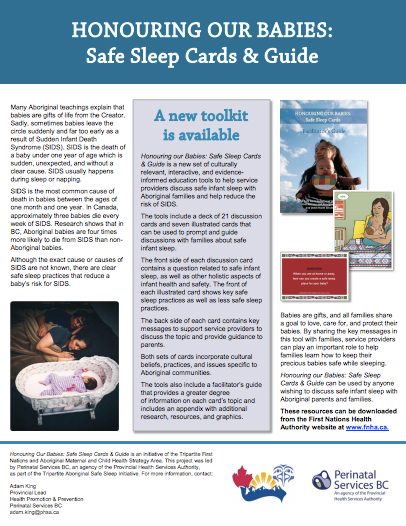New Safe Infant Sleep Toolkit: Honouring Our Babies
 Sudden Infant Death Syndrome (SIDS) is the death of a baby under one year of age which is sudden, unexpected and without a clear cause. SIDS usually happens during sleep or napping and is the most common cause of death in babies between the ages of one month and one year.
Research has shown that, in BC, First Nations and Aboriginal babies are four times more likely to die from SIDS than other babies in BC. Although the exact cause or causes of SIDS are not known, safe sleep practices have been identified that reduce a baby’s risk for SIDS.
Sudden Infant Death Syndrome (SIDS) is the death of a baby under one year of age which is sudden, unexpected and without a clear cause. SIDS usually happens during sleep or napping and is the most common cause of death in babies between the ages of one month and one year.
Research has shown that, in BC, First Nations and Aboriginal babies are four times more likely to die from SIDS than other babies in BC. Although the exact cause or causes of SIDS are not known, safe sleep practices have been identified that reduce a baby’s risk for SIDS.
Responding to direction from the Transformative Change Accord for First Nations Health Plan, focusing on addressing issues arising from the BC Coroner’s Office Child Death Review Report, the Tripartite First Nations and Aboriginal Maternal and Child Health Committee, led by perinatal Services BC, have produced a new education toolkit, Honouring Our Babies: Safe Sleep Cards & Guide, that includes a deck of 21 discussion cards and seven illustrated cards that can be used to prompt and guide discussions with families about safe infant sleep. The toolkit includes a facilitator’s guide with information, research, resources and graphics. The toolkit is designed to be interactive, evidence-informed, and to incorporate cultural beliefs, practices and issues specific to First Nations and Aboriginal communities.
The toolkit is downloadable in pdf format from the website, and includes:
- A backgrounder
- Discussion Cards (in original size)
- Discussion Cards (in print size)
- Illustrated Cards (in original size)
- Illustrated Cards (in print size)
- A Facilitator’s Guide
The front side of each discussion card contains a question related to safe infant sleep, as well as other holistic aspects of infant health and safety. The front of each illustrated card shows key safe sleep practices as well as less safe sleep practices. The reverse side of each card contains key messages to support service providers to discuss the topic and provide guidance to parents. The Facilitator’s Guide provides a greater degree of information on each card’s topic and an appendix with additional research, resources and graphics.
Topics addressed in the discussion cards include:
- When you are at home or away, how can you create a safe sleep place for your baby?
- What position do you put your baby to sleep in for naps and at night?
- Is your baby around cigarette smoke?
- Do you plan on having your baby sleep in the same room as you?
- Can breastfeeding provide some protection against SIDS?
- Do you worry that your baby won’t be warm enough when sleeping?
- Does your baby have his or her own sleeping surface that is firm?
- What do you need to know about your crib, cradle or bassinet?
- If you have decided to share a bed with your baby, how can you make it as safe as possible?
- Have you considered talking to your family, elders or cultural support about cultural traditions of safe sleep?
- What are the cultural ceremonies in your community related to childbirth?
- If your baby is fussy or cries a lot, in what position should you put your baby to sleep in?
- Is your baby spitting up a lot: Do you worry that your baby may choke while sleeping on his or her back?
- What is your safety plan for your baby if you attend an event where there may be alcohol or substance use?
- How can you keep baby safe if you need to take medications that make you sleepy?
- Are you having a difficult time trying to quit smoking cigarettes?
- What should you do when your baby falls asleep in a car seat, stroller, or baby swing?
- If you do not have access to a crib, cradle or bassinet, what can you use to make a safe sleep place for your baby?
- Do you sometimes store clothes or toys in the crib or bassinet?
- Does your baby need time on the tummy when he or she is awake?
- Is everyone giving you different ideas about taking care of your baby?
Topics addressed on the illustrated cards include:
- Identifying safe infant sleep practices in a picture of a bedroom scene
- Identifying safe practices in a picture of a breastfeeding mother in a bedroom
- Identifying safe infant sleep practices when staying overnight away from home
- Identifying unsafe infant sleep practices associated with exposure to cigarette smoke
- Identifying unsafe infant sleep practices associated with overheating
- Identifying unsafe sleep practices associated with sleeping on a soft surface or in proximity to soft objects
- Choosing safe infant sleep options when visiting in other people’s homes
For information on training sessions and availability of hard copies, contact Adam King, Provincial Lead, Health Promotion & Prevention, Perinatal Services BC at 604-877-2121.
